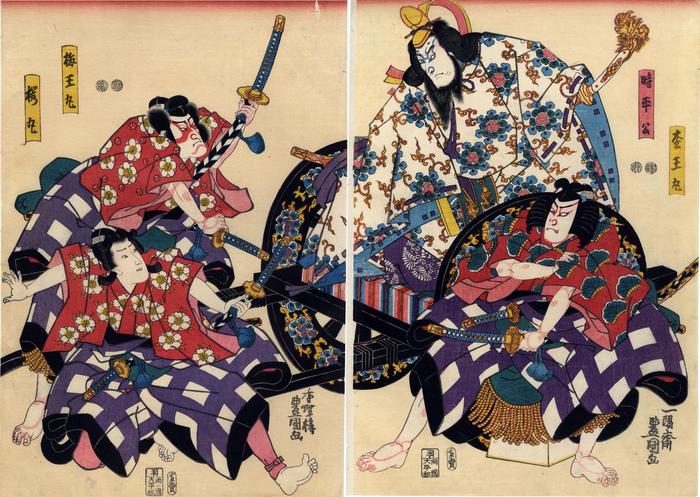Utagawa Kunisada (歌川国貞) / Toyokuni III (三代豊国) (artist 1786 – 01/12/1865)
Morita Kan'ya XI as Shihei-Kō (時平公) with Arashi Rikaku II as Matsuomaru (松王丸) on the right and Seki Sanjurō III as Umeōmaru (梅王丸) with Onoe Kikujirō II as Sakuramaru (桜丸) on the left in the Kuruma biki or 'Pulling the carriage apart' scene
1850
20 in x 14 in (Overall dimensions) Japanese color woodblock print
Signed (on right): Ichiyōsai Toyokuni ga
一陽斎豊国画
Signed (on left): Kōchōrō Toyokuni ga
香蝶楼豊国画
Publisher: Daikokuya Heikichi (Marks 029 - seal 22-094)
Censors: Mera & Murata
Seal: shita-uri (シタ売)
Waseda University - right sheet
Waseda University - left sheet The Secret of Sugawara's Calligraphy (Sugawara Denju Tenarai Kagami - 菅原伝授手習鑑) was performed at the Nakamura-za on 7/13/1850 and at the Ichimura-za on 7/10/1850.
In a description of a different triptych of the same scene shown in the Lyon Collection, the Herwigs wrote: "Umeōmaru and Sakuramaru opposing their brother Matsuōmaru, who protects the carriage (kuruma) of his lord. After some pushing and pulling, the carriage has fallen apart, revealing the evil courtier (kuge-aku Fujiwara Shihei as a fearsome blue-faced (ai-guma) demon. The triplet brothers having thrown off the upper part of their checkered over-kimono, can be identified by the motifs on their red under-kimono: plum (ume, cherry (sakura) and pine matsu. Each brother has a different facial make-up and hairdo."
****
Samuel L. Leiter wrote about the background to this same scene: "Pulling the Carriage Apart was originally a brief and unimportant scene placed as a curtain-raiser to the main scene of Act III. When taken over by Kabuki it was performed in the dynamic bravado style called aragoto ('wild style') and, in its perfected form, was so outstanding a vehicle that the puppet theater dropped its own method of performing the scene in favor of the Kabuki approach. The piece has since come to be considered a quintessential example of the aragoto style, a style which has long been the domain of Tokyo actors, ever since it it was created by the first Danjūrō (1660-1704) and developed by his descendants. Aragoto is known as the 'family art' (ie no gei) of the Danjūrō line and actors in this family have made a number of distinctive contributions to the play's performance. Two of the chief roles, Umeō and Matsuō (shortened forms by which Umeomaru and Matsuomaru are often called), are classic examples of the aragoto superman type though their brother, Sakuramaru, is always played in the wagoto ('gentle style') tradition, a far more delicate and romantic style. When the play is produced in the Kyoto-Osaka area the aragoto qualities are slightly reduced as that region favors the wagoto style.
Pulling the Carriage Apart has barely any plot, merely being a confrontation between Sakuramaru and Umeō with their supposed traitor-brother, Matsuō, and his lord, Fujiwara no Shihei. Yet, the thirty minutes or so that the play takes up in performance provide audiences with one of the most brilliant displays of of Kabuki spectacle and excitement. The piece is a perfect example of the printed page's limitations in conveying the magic with which theatrical performance can infuse a script. When, in 1973, spectators at the Kennedy Center's Eisenhower Theatre in Washington, D.C., were treated to a performance of this work by the young actors in training at Japan's National Theatre, they understood at once why writers such as Hamamura Yonezō have called this 'the most Kabuki-esque of all Kabuki plays.' "
****
There is another copy of this diptych in the Kyushu National Museum.
****
The evil, menacing fellow who appears when the cart is torn apart is Fujiwara no Shihei (藤原時平). The characters of his name can also be read as Fujiwara Tokihira (871-909). He is the Minister of the Left and wants to be emperor.
The historical Fujiwara Tokihira was jealous of the power and influence of Sugawara Michizane and was part of the plot to discredit his rival by convincing the young, seventeen year old emperor that he must act against Michizane. For this reason, the innocent Michizane was banished from the court and died in exile. His wronged ghost became one of the fiercest portrayed in Japanese theater.
****
The term shita-uri as a special meaning according to Sarah Thompson in Undercurrents in the Floating World: Censorship and Japanese Prints in describing a multi-panel composition on pages 52-53: "A further concession to the reform laws, the print bears a special seal on each sheet reading shitauri, or "selling below," indicating that it could be sold only from the counter and not hung up for display at the front of the store."
****
Illustrated in a color reproduction in Japanese Woodblock Prints: Artists, Publishers and Masterworks 1680-1900 by Andreas Marks, Tuttle Publishing, 2010, page 275.
Morita Kan'ya XI (十一代目守田勘弥) (actor)
actor prints (yakusha-e - 役者絵) (genre)
Arashi Rikaku II (二代目嵐璃珏: 11/1831 to 7/14/1864) (actor)
Onoe Kikujirō II (二代目尾上菊次郎: 11/1835 to 12/1856 and 1858 to June 1875) (actor)
Seki Sanjūrō III (三代目関三十郎: 4/1840 to 12/1870) (actor)
Daikokuya Heikichi (大黒屋平吉) (publisher)
Kabuki (歌舞伎) theater terms (genre)
